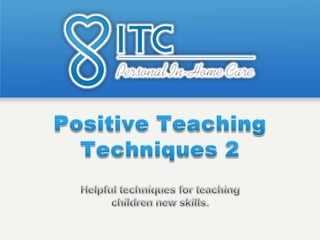
Positive teaching techniques pt 2
- 2. In Part 1 of Positive Teaching Techniques, we covered 9 techniques: Active Listening Chaining Cues/Prompts Differential Reinforcement Discrimination Training Environmental Manipulation Fading of Cues/Prompts Generalization Training Graduated Guidance
- 3. In Part 2 of Positive Teaching Techniques, we will cover 8 more techniques: Incidental Teaching Modeling Redirection Reinforcement Relaxation Training Shaping Token Economics Voluntary Time Out
- 4. This involves using “teachable moments” Those who support individuals use normally occurring situations as well as random and unplanned occurrences to provide “on the spot teaching”
- 5. Using slide shows, role play, or flip cards can useful in teaching “Stranger Danger”. If you’re out in the community, and a stranger offers the consumer a piece of candy, take the time to teach about Stranger Danger right then and there. Using this unplanned occurrence can be a helpful tool to understanding Stranger Danger. This is what’s called a “teachable moment”
- 6. Demonstrating the desired behavior to be imitated.
- 7. If the consumer sees you doing the dishes, it’ll be easier for them to want to learn to do dishes. Any new activity or skill can seem scary or unrealistic, but if they see someone they trust doing it, it is more likely they will be receptive. Model the behavior you would like to see in them.
- 8. A technique where the person is instructed to a different area, activity, choice, or focus in order to interrupt the current behavior, AND then problem solving to address the reason for the behavior, and/or training the acceptable replacement behavior.
- 9. If a consumer is throwing a tantrum over the TV being turned off… • direct them to a different activity. “Would you like to make cookies or go to the park?” • Take them into a different room • Focus them on something else like a phone, book, or toy That’s the first half!
- 10. After interrupting the current behavior, then use problem solving to address the reason for the behavior. Now that you’re at the park, “Why did you get so upset when the TV was turned off?” “What can we do next time so you know when it’s time to change activities?” “Let’s set up a chart, or have a timer.”
- 11. Any event/item that immediately follows a behavior which increases the likelihood of the behavior occurring again. This includes gaining objects, activities, interactions, occurrences or tokens/symbols
- 12. Creating a system to reward good behavior. i.e. Brushing teeth=5 minutes of computer time Helping clean up after dinner=cookie Tying shoe=sticker Getting dressed independently=2 stickers Each math problem=1 point 10points=$1 Find what works for your consumer, and use it as a reward for positive behavior.
- 13. Using different strategies help a person remain calm or use self calming techniques in situations that otherwise produce stress or anxiety.
- 14. If your consumer is stressed, anxious, or angry, try one of the following relaxation techniques: • Deep breathing • Laying down • Visualizing a calm space • Counting to 20 • Going for a walk • Yoga • Listening to music • Being by yourself • A warm bath
- 15. A procedure that reinforces, in a planned sequence, closer and closer steps to learning a skill.
- 16. To Teach John to complete a worksheet. Start with the simplest task, and gradually increase it until it’s completed. 1. John will write his name at the top of the worksheet. 2. John will complete one problem of his choice. 3. John will complete five problems of his choice. 4. John will complete either all the odd numbered problems or all the even numbered problems. 5. John will complete all problems except one. 6. John will complete all problems.
- 17. A reward system where symbols are given for positive behavior, then saved and exchanged for items of larger value. Symbols can be poker chips, stars on a chart, stickers, checks on a calendar, etc.
- 18. Full chart=going out for ice cream Picking up Toys Washing Hands Saying “Please” 10 poker chips=1 hour of computer time 25 stickers= new toy 30 checks on Calendar=going to a movie
- 19. A procedure where the individual chooses to go to an area away from others to allow time and space to deal with stressors in the environment or feelings that can lead to difficult behavior. MUST be voluntary.
- 20. When a consumer is in a stressful environment, or is becoming agitated, let them go to an area away from others, homework, or whatever is causing them stress. It must be voluntary.
- 21. Applying these positive teaching techniques: Incidental Teaching Modeling Redirection Reinforcement Relaxation Training Shaping Token Economics Voluntary Time Out Will help create a positive learning environment for both you and your consumer.
- 22. Active Listening Incidental Teaching Chaining Modeling Cues/Prompts Redirection Differential Reinforcement Reinforcement Discrimination Training Relaxation Training Environmental Manipulation Shaping Fading of Cues/Prompts Token Economics Generalization Training Voluntary Time Out Graduated Guidance